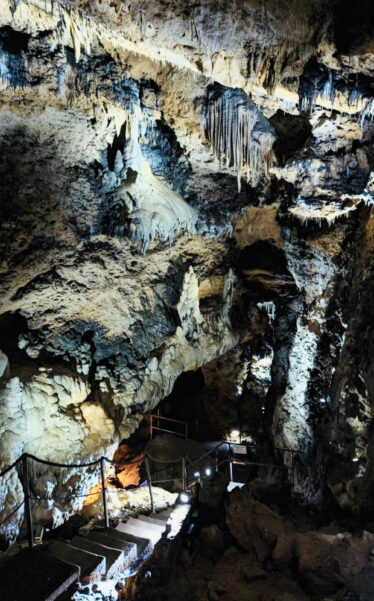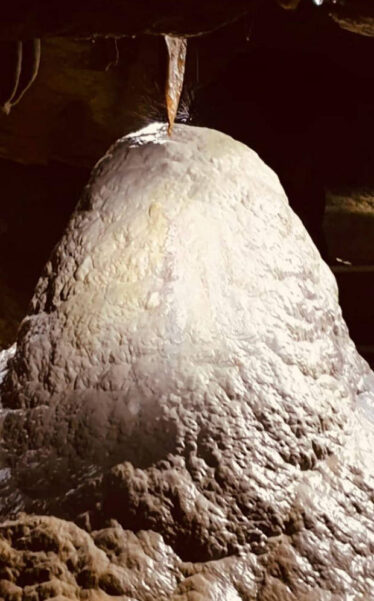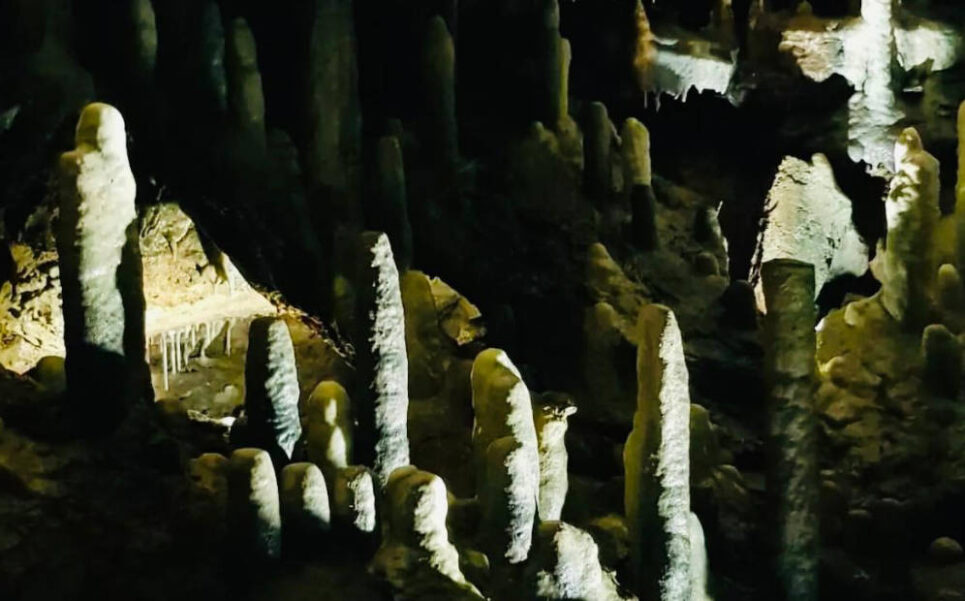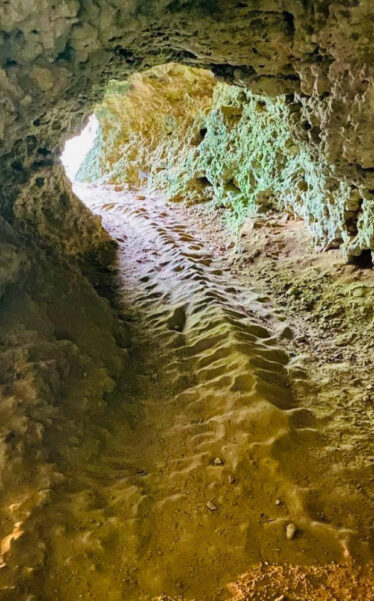In Germany, there are many different types of caves. There are water and ice caves with fascinating formations. Few would believe it, but in the heart of Bavaria, Germany, there exists a magical corner.
The place is somewhat eerie but magically beautiful at the same time. We are talking about the Sophie Cave, a true hidden treasure in the heart of nature. With its spectacular rock formations, fascinating caverns, and lush natural surroundings, this geological wonder captivates adventurers and nature lovers alike.
Important Facts
The cave is located on the northwest edge of the Ailsbach Valley, not far from Rabenstein Castle in Franconian Switzerland. The Ailsbach Valley is near the community of Ahorntal, in the Bayreuth district of Upper Franconia.

The entrance to the cave is 411 meters above sea level, the valley is 375 meters above sea level, and the Chapel of Klausstein above it, on the site of the former Castle of Ahorn, is at 443 meters above sea level.
You can reach the cave from the Rabenstein Castle parking lot, located to the west of the cave, via a 650-meter-long path, and from the parking lot situated 30 meters below the cave, directly on state road 2185, a steep 120-meter path leads upward.
With three large sections and winding passages, the Sophie Cave is considered one of the most beautiful show caves in Germany.

The cave was formed in stagnant groundwater along largely horizontal joints. Carbonated water (water that contains carbonic acid (H2CO3), which is unstable and easily decomposes into water and carbon dioxide (CO2)) was able to penetrate through small cracks and fissures in the rock.
Although carbonic acid is a relatively weak acid, it can dissolve limestone and dolomite rocks. Large cavities formed through leaching along numerous cracks and fissures. A deep descent of the Ailsbach Valley caused a decrease in the groundwater level, exposing the cavities. Subsequently, the halls and passages were partially filled with sediments, partially separating the front compartments.
The cave was discovered in 1969 during the construction of a highway near the town of Blaubeuren. Since then, it has been the subject of numerous investigations that have revealed its continued use by humans for millennia. Archaeologists have found evidence of human occupation from the Upper Paleolithic, about 40,000 years ago, to the Iron Age and the medieval period.
Numerous bones of Ice Age animals have been found in the cave, with cave bear remains being the most abundant. Long ago, bears used the Sophie Cave during winter hibernation to give birth to their young. During this time, some animals died from old age or diseases. Over time, this led to the accumulation of a large number of bones.

The age of the bones in Franconian Jura is estimated to be between 28,500 and 60,000 years. The bear bones in the Sophie Cave mainly come from the Würm glacial period. No specific dating has been performed for the Sophie Cave.
In the first section of the cave, in addition to cave bear bones, isolated remains of mammoths, woolly rhinoceroses, and reindeer were found. According to ancient cave reports, the Sophie Cave is notable in the Franconian Jura for its abundance of reindeer remains. However, most fossils found in the Sophie Cave have been lost. Many were stored in the nearby Rabenstein Castle. Some have the State Collection of Paleontology in Munich, such as a fragment of a jawbone from a Pleistocene lion.
In addition to its archaeological value, the Sophie Cave is also notable from a geological standpoint. Formed about 175 million years ago during the Jurassic period, the cave exhibits impressive rock formations and stalactites that have attracted spelunkers and geology enthusiasts.
Tourism
Although the cave is not open to the general public due to its fragility and to protect its valuable archaeological contents, guided tours, and educational activities are organized under expert supervision. This allows visitors to learn about the history and geology of the site responsibly and respectfully.

The management of tourism around the Sophie Cave in Germany is carried out carefully and in a controlled manner, prioritizing the conservation of its valuable archaeological and geological resources.
Due to the fragility of the archaeological remains and geological formations within the cave, access is strictly controlled. Free visits are not allowed to preserve the site from possible damage caused by unsupervised tourists.
For those interested in exploring the cave, guided tours led by experts are organized. These tours not only provide detailed information about the history and geology of the place but also ensure that visitors respect conservation regulations.
Education and awareness about the importance of the cave’s archaeological and geological heritage are emphasized. Guides inform visitors about the reasons behind access restrictions and the need to preserve the site for future generations.
Active conservation measures are implemented to protect the structures and artifacts within the cave. This may include controls on humidity, temperature, and limitations on the number of visitors per day or season.
Ongoing scientific research within the cave is encouraged to increase knowledge about its history and geological formation. Findings from this research often influence management and conservation decisions for the site.
Although not promoted as a mass tourist attraction, the Sophie Cave is selectively marketed among enthusiasts of archaeology, geology, and history. This ensures that visitors accessing the site are genuinely interested in learning and valuing its importance.
The Sophie Cave is much more than a tourist attraction: it is a natural sanctuary that requires care and protection. The cave guardians are committed to conserving and preserving this invaluable natural resource, implementing measures to protect the unique ecosystem it houses. Visitors are encouraged to respect the rules and regulations established to protect the cave and its surroundings, ensuring that future generations can enjoy its beauty and wonder.
Legends
The Sophie Cave is steeped in history and legend that date back centuries. According to local tradition, the cave is named after a mysterious maiden named Sophie, whose story is shrouded in mystery and intrigue.

The most famous legend surrounding the Sophie Cave is the story of the missing maiden who lends her name to the cave.

It is said that Sophie was a beautiful young woman who got lost in the cave centuries ago and was never found. Her spirit is believed to still wander through the dark passages of the cave, adding a touch of mysticism and romance to the experience for visitors.
Despite the locals’ efforts to find her, Sophie was never located, and her fate remains a mystery to this day. It is said that her spirit still roams the dark passages of the cave, searching for the exit she never found.
Another legend that has intrigued adventurers is the story of the hidden treasure of the Knights Templar.
It is rumored that the Templars, in their quest for a safe place to hide their riches, used the Sophie Cave as a secret storage for their most prized treasures.
Over the centuries, treasure hunters have attempted to uncover the whereabouts of this lost wealth, but so far, the Templar treasure remains a well-kept secret hidden within the depths of the cave.
According to some versions of the legend, the Sophie Cave is more than just a place of natural beauty; it is a mystical portal that connects the world of the living with the realm of spirits.

It is said that on certain full moon nights, the veil between the two worlds becomes thin, allowing the spirits of the ancient inhabitants of the cave to manifest in our world.
Locals tell tales of strange flickering lights, whispers in the darkness, and ghostly figures lurking in the shadows, adding an aura of mysticism and supernatural to the cave.
Another enduring legend is the story of the guardian of the depths, a mysterious creature that protects the secrets of the cave.
Described as a dark shadow lurking in the shadows, the guardian is said to vigilantly watch over the entrance to the cave, scaring away intruders and keeping the curious at bay.
Some brave adventurers claim to have seen glimpses of its glowing eyes in the darkness, while others believe it is merely a product of imagination.
In conclusion, the legends of the Sophie Cave add a layer of mystery and fascination to this natural wonder, transforming it into a place of intrigue and excitement.
Whether searching for the trace of the missing maiden, seeking the Templar treasure, or simply enjoying the serene beauty of the cave, visitors are transported to a world of fantasy and wonder that lingers long after they have returned to the light of day.
Subterranean Natural Wonder
A visit to the Sophie Cave is an opportunity to reconnect with nature and marvel at its grandeur. As visitors delve into the depths of the cave, they are transported to another world where time seems to stand still, and the beauty of nature is revealed in all its glory. From the delicate beauty of the rock formations to the serene tranquility of its hidden chambers, the cave offers a rejuvenating escape from everyday life and an opportunity to reflect on the importance of preserving and protecting our natural environment.

The Sophie Cave is a natural jewel that offers a fascinating glimpse into the underground world. Known for its stunning stalactites and stalagmites, unique rock formations that have formed over millennia, the cave provides a visual spectacle that leaves visitors breathless. Immerse yourself in the depths of the earth and explore its intricate chambers and passages, marveling at the beauty and complexity of nature in its most primitive state.

Located in a picturesque natural setting near Stuttgart, the cave is surrounded by wooded and mountainous landscapes that complement its beauty. The combination of its location and geological formations makes it an attractive destination for nature lovers and geology enthusiasts.
In addition to its aesthetic aspect, the Sophie Cave holds significant scientific value.
The archaeological findings within the cave provide crucial information about human evolution and the prehistoric cultures that inhabited the region.
This combination of natural beauty and cultural richness makes it a gem for research and education.
It is essential to remember that caves with such well-preserved geological formations and access for research are uncommon. Therefore, the Sophie Cave is a valuable resource that future generations should preserve and appreciate.
Concluding
In conclusion, the Sophie Cave is much more than just a tourist attraction: it is a natural sanctuary that holds secrets and wonders waiting to be discovered.
The Sophie Cave is also an important cultural and tourist site in Bavaria. It is a place where science, education, and scenic beauty come together.
Whether exploring its depths in search of adventure, immersing yourself in its history and legends, or simply enjoying the serene beauty of its surroundings, a visit to the Sophie Cave promises an unforgettable experience that will linger in your memory long after you have returned to the surface.


